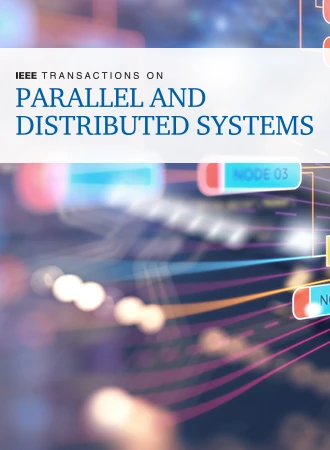FedVeca: Federated Vectorized Averaging on Non-IID Data With Adaptive Bi-Directional Global Objective
IF 5.6
2区 计算机科学
Q1 COMPUTER SCIENCE, THEORY & METHODS
IEEE Transactions on Parallel and Distributed Systems
Pub Date : 2024-09-04
DOI:10.1109/TPDS.2024.3454203
引用次数: 0
Abstract
Federated Learning (FL) is a distributed machine learning framework in parallel and distributed systems. However, the systems’ Non-Independent and Identically Distributed (Non-IID) data negatively affect the communication efficiency, since clients with different datasets may cause significant gaps to the local gradients in each communication round. In this article, we propose a Federated Vectorized Averaging (FedVeca) method to optimize the FL communication system on Non-IID data. Specifically, we set a novel objective for the global model which is related to the local gradients. The local gradient is defined as a bi-directional vector with step size and direction, where the step size is the number of local updates and the direction is divided into positive and negative according to our definition. In FedVeca, the direction is influenced by the step size, thus we average the bi-directional vectors to reduce the effect of different step sizes. Then, we theoretically analyze the relationship between the step sizes and the global objective, and obtain upper bounds on the step sizes per communication round. Based on the upper bounds, we design an algorithm for the server and the client to adaptively adjusts the step sizes that make the objective close to the optimum. Finally, we conduct experiments on different datasets, models and scenarios by building a prototype system, and the experimental results demonstrate the effectiveness and efficiency of the FedVeca method.FedVeca:非 IID 数据的联合矢量化平均与自适应双向全局目标
联合学习(FL)是并行和分布式系统中的一种分布式机器学习框架。然而,系统中的非独立和相同分布(Non-IID)数据会对通信效率产生负面影响,因为拥有不同数据集的客户端可能会在每轮通信中对本地梯度造成巨大差距。在本文中,我们提出了一种联邦矢量化平均(FedVeca)方法,用于优化非独立同分布数据的 FL 通信系统。具体来说,我们为全局模型设定了一个与局部梯度相关的新目标。根据我们的定义,局部梯度被定义为具有步长和方向的双向向量,其中步长是局部更新的次数,方向分为正向和负向。在 FedVeca 中,方向受步长的影响,因此我们将双向向量平均化,以减少不同步长的影响。然后,我们从理论上分析了步长与全局目标之间的关系,并得出了每轮通信的步长上限。在此基础上,我们为服务器和客户端设计了一种算法,用于自适应地调整步长,使目标接近最优。最后,我们通过构建原型系统,在不同的数据集、模型和场景下进行了实验,实验结果证明了 FedVeca 方法的有效性和高效性。
本文章由计算机程序翻译,如有差异,请以英文原文为准。
求助全文
约1分钟内获得全文
求助全文
来源期刊

IEEE Transactions on Parallel and Distributed Systems
工程技术-工程:电子与电气
CiteScore
11.00
自引率
9.40%
发文量
281
审稿时长
5.6 months
期刊介绍:
IEEE Transactions on Parallel and Distributed Systems (TPDS) is published monthly. It publishes a range of papers, comments on previously published papers, and survey articles that deal with the parallel and distributed systems research areas of current importance to our readers. Particular areas of interest include, but are not limited to:
a) Parallel and distributed algorithms, focusing on topics such as: models of computation; numerical, combinatorial, and data-intensive parallel algorithms, scalability of algorithms and data structures for parallel and distributed systems, communication and synchronization protocols, network algorithms, scheduling, and load balancing.
b) Applications of parallel and distributed computing, including computational and data-enabled science and engineering, big data applications, parallel crowd sourcing, large-scale social network analysis, management of big data, cloud and grid computing, scientific and biomedical applications, mobile computing, and cyber-physical systems.
c) Parallel and distributed architectures, including architectures for instruction-level and thread-level parallelism; design, analysis, implementation, fault resilience and performance measurements of multiple-processor systems; multicore processors, heterogeneous many-core systems; petascale and exascale systems designs; novel big data architectures; special purpose architectures, including graphics processors, signal processors, network processors, media accelerators, and other special purpose processors and accelerators; impact of technology on architecture; network and interconnect architectures; parallel I/O and storage systems; architecture of the memory hierarchy; power-efficient and green computing architectures; dependable architectures; and performance modeling and evaluation.
d) Parallel and distributed software, including parallel and multicore programming languages and compilers, runtime systems, operating systems, Internet computing and web services, resource management including green computing, middleware for grids, clouds, and data centers, libraries, performance modeling and evaluation, parallel programming paradigms, and programming environments and tools.
 求助内容:
求助内容: 应助结果提醒方式:
应助结果提醒方式:


